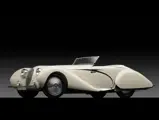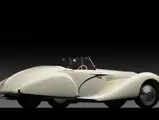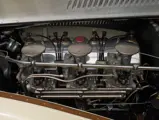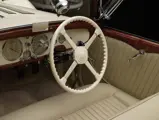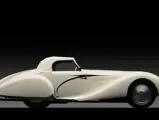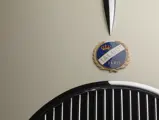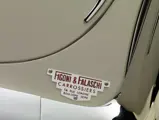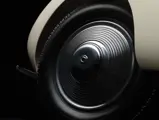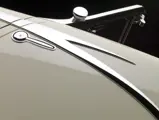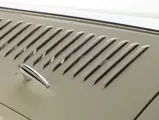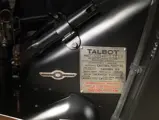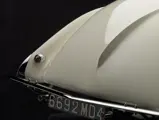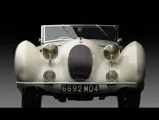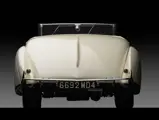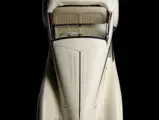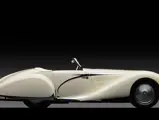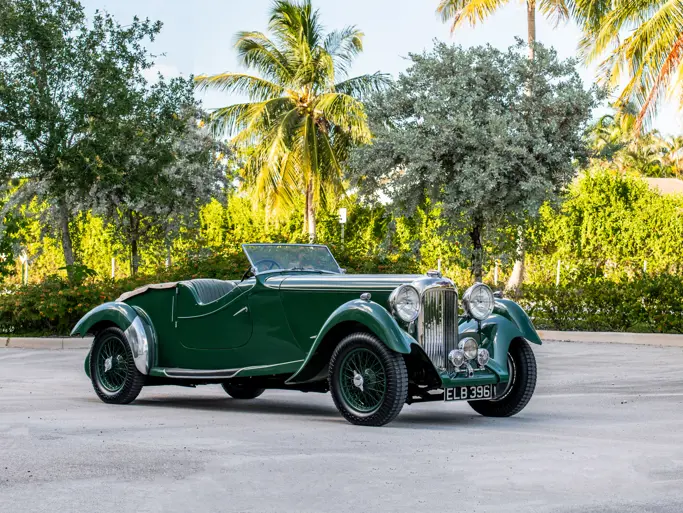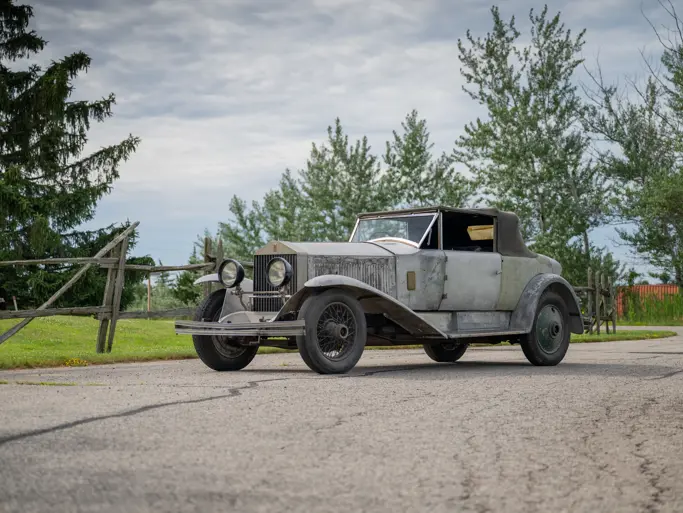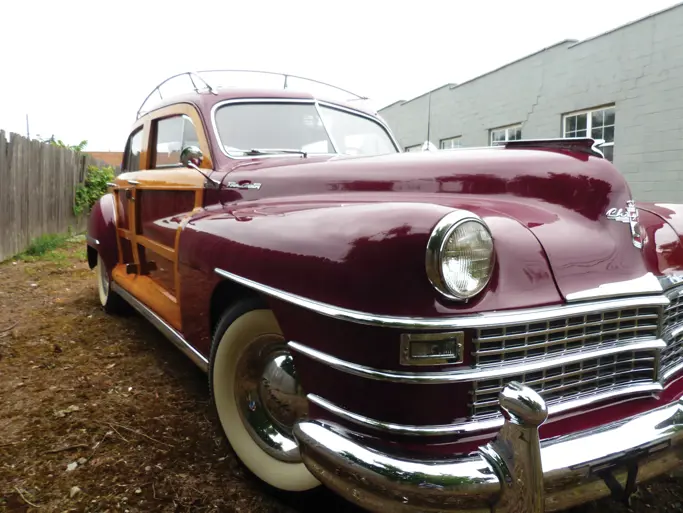New York - Art of the Automobile 2013
1938 Talbot-Lago T150-C SS Teardrop Cabriolet by Figoni et Falaschi
{{lr.item.text}}
$7,150,000 USD | Sold
 | New York, New York
| New York, New York
{{internetCurrentBid}}
{{internetTimeLeft}}

- A landmark in French Art Deco design
- The first in a series of Figoni et Falaschi Teardrop Cabriolets
- The only short-wheelbase example with original chassis, engine, and body
- Outstanding, recent concours-quality restoration
There is little doubt that the exuberant French coachwork of the late 1930s precipitated a monumental change in automotive design. Gone were the largely functional forms of the 1920s and early 1930s, as they were replaced by fanciful curves and sensuous lines that ushered in the era of the automobile as art. Although others were versed in the style of the age to one degree or another, it was the Parisian firm of Figoni et Falaschi that was widely regarded as the innovator of the new look.
Figoni’s early work was quite conservative, as it was probably a reflection of the wishes of his affluent clientele. Nonetheless, his early designs showed a sophisticated sense of line and proportion. Far from extravagant, these early cars were like a well-tailored suit: impeccable craftsmanship combined with just enough flair to stand out from the ordinary.
By the turn of the decade, Figoni had begun to earn commissions for racing cars, and these unlikely orders began to shift the coachbuilder’s image and reputation in a more sporting direction. Alfa Romeo, Lancia, Bugatti, and other sporting marques began to appear more prominently in his shop. These years also saw the birth of Figoni’s aeronautically inspired designs. The coachbuilder’s shop was located near an airfield, and he was a daily witness to aerodynamic efficiency. The curved shapes of the aircraft were to become a major inspiration in Figoni’s creations.
In 1935, several pivotal events took place for Figoni and French automotive design. In May of that year, Joseph Figoni took on a partner. Ovidio Falaschi, a successful Italian businessman, was to provide working capital and business expertise. By all accounts, the partnership was a success, with both men making substantial contributions.
The second event was the development of the Delahaye 135 in 1935 and 1936. The 135 introduced a lower radiator and independent suspension, which not only dramatically improved the car’s handling, but also lowered the chassis. These innovations created the canvas upon which Figoni designed the 1936 Paris Auto Show car.
It was during the later half of the 1930s that Figoni turned his attention to Talbot-Lago, whose mission was to build the finest French cars of the era. Few will disagree that the coachbuilder’s collaboration with that manufacturer achieved this lofty goal. Talbot-Lago’s reliable, new 140-horsepower engine would provide the basis for a powerful new chassis, and the glory of Talbot-Lago’s racing record (the firm’s entrants placed 1st, 2nd, 3rd, and 5th at the 1937 French Grand Prix) would provide the perfect image to attract wealthy and powerful new clients to his order book.
Talbot’s greatest achievement was the T150-C chassis. The “C” stood for competition, which was a reference to the car’s racing success. Two versions of the race-derived chassis were offered. The first of these is designated “SS” and denoted by a 901 comprising the first three digits of the chassis number. It refers to a 2.65-meter short-wheelbase chassis, which was designed for elegant two- or three-place coachwork. As the shortest and lightest chassis, it was generally the one used as the basis for the company’s racing efforts.
When considering the Talbot-Lago automotive masterpieces that have been bodied by Figoni & Falaschi, there is no word more appropriate, or more frequently employed, than the term “fluid.” The designs were defined by their sleek appearances, and they almost seemed to be liquid caught in a moment of solidity. When the automotive press began to use the term goutte d’eau, or “teardrop,” to describe these automobiles, the word and its meaning were immediately adopted as the symbol of the automotive streamlining era. The best known examples of this genre were a small series of 16 or so coupes, after which Figoni happily responded to demand for coachwork, which would allow its occupants to enjoy warm, open-air touring.
The resulting cabriolets were, and are, simply stunning. One of the most striking aspects of the evolution of the design from closed to open is the graceful chrome beltline that sweeps back from the hood line before splitting in two, with one tail continuing the sweeping line and the second arching down into the door. This is a classic Figoni detail, and it is the perfect embellishment.
In 1938, Figoni & Falaschi was already setting Paris on fire with beautiful, sumptuous automobiles. According to the Figoni archives, it was in that year that the factory produced the three cabriolets that would come to be seen as the epitome of the teardrop style. Chassis 90111, 90019, and 90115 were all created for the Talbot-Lago T150-C; although, the first and last were built on shorter SS chassis. Of these two, the example offered here is the only one to retain its original coachwork.
In Talbot-Lago, Figoni discovered an ideal chassis for his characteristic and charismatic teardrop style. Many modern car authorities still consider Figoni’s T-150-C models to be some of the most beautiful cabriolets ever built. These three automobiles were the only Talbot-Lago Teardrop Cabriolets ever created by Joseph Figoni.
The first of the three cabriolets was this car, chassis 90111 and Figoni factory order number 661; it was a prototype built for display at a Parisian concours, with the intent being to create interest in Figoni’s groundbreaking styling. Its Talbot-Lago T150-C SS chassis was topped with a body of shimmering ivory and red fenders, and the car easily caught the notice of every concours attendee.
Chassis 90111 was first registered in 1938 by Michael Dassonville, of Lille, a young wool merchant with a successful family business and enough resources to become a serious car collector. By 1941, Dassonville had moved to Paris, taking 90111 with him and re-registering it with a Paris number. Though the Germans had occupied France, Dassonville maintained his business interests. Reportedly, Dassonville was a double agent who escaped to Brazil in 1944 or 1945, leaving 90111 behind.
Likely confiscated by the French government after the abrupt departure of its former owner, chassis 90111 was sold to Lino Fayen, in Paris, in 1952, and it was driven with the same registration numbers as 90115, which was also owned at the time by Fayen. Reportedly, Fayen found it more convenient to swap license and chassis plates whenever he chose to drive one of the Talbot-Lagos, rather than endure a French taxation system that penalized owners of cars with large-capacity engines. Fayen later sold 90111 to George Leroy, of Montvilliers, who continued to use it with 90115’s license number, 796 CA76.
In the mid-1950s, American Vojta F. Mashek, of Chicago, purchased 90111, along with several other Talbot-Lagos. This car became an important centerpiece of his 50-car collection. In 1962, he raced it at the De Wilmot Hills Race Course in the rural Chicago area. This event was organized by the Vintage Sports Car Club of America, and Mr. Mashek won the five-lap race!
Although Mr. Mashek passed away in 1973, it was not until 2006 that the car was put up for sale by his family. It was purchased by the current owner in 2008, and he added it to his collection in the Southeastern United States. After careful research, the owner commissioned a complete restoration. The restoration of an automobile of this caliber and historical importance is almost a sacred trust. It is important to not only restore the car to new condition mechanically and operationally, but also to ensure that the visual beauty of the original design is carefully restored.
As such, the restoration began with a thorough inventory and dismantling of the car. Most notably, every critical component was observed to have originally been stamped with the Figoni reference number 661, confirming that this was for sure chassis 90111. Although the car proved to be remarkably complete overall, the decision was made that, given the rarity and importance of the car, it would be taken back to its very foundation and completely rebuilt.
As a result, although most of the original wood framework survives, every joint was carefully taken apart, cleaned, and refastened; only a few pieces in the lower portions of the doors and sills required replacement with new pieces of seasoned ash. The sheet metal also remains largely intact, except for the correction of a few old repairs that had been poorly done. Wherever metalwork was required, identical materials and workmanship were used to ensure the faithful restoration of the coachwork that Figoni built so many years ago.
The frame was in excellent condition, and it required little more than a thorough cleaning and repainting. Similarly, the original chassis components were rebuilt and reinstalled, including the suspension and steering. The original cable brake system was reinstalled and set up to exact factory standards. The drivetrain was also complete, but every component required both mechanical rebuilding and cosmetic refurbishing. An intensive program of research was undertaken to ensure that each detail was faithful to the original materials and finish.
The interior trim and upholstery is identical in form and pattern to the originals, the woodwork was carefully repaired and properly refinished, and the carpet, convertible top, and upholstery were meticulously cut and fitted to match the original patterns. Each instrument was restored, and a new wiring harness was fabricated for the complete car. Each light, bezel, and lens was carefully rebuilt and reinstalled.
Hundreds of hours were dedicated to careful preparation for painting. The finish, which is a correct shade of cream white, was color-sanded and buffed to provide a superior shine and finish quality. Chassis 90111 debuted at the 2012 Pebble Beach Concours d’Elegance, winning First in Class; this ia a prestigious honor in what is traditionally one of the most competitive of classes.
Any Talbot-Lago is a rare and delightful thing today, but the startling beauty and underlying engineering excellence of the Teardrop Cabriolet makes it the crowning achievement of the company. Offered here is the original prototype, with its original coachwork, engine, and chassis. It is a splendid example of goutte d’eau design, and it has been restored with the perfection of nature’s most aerodynamic shape.






































